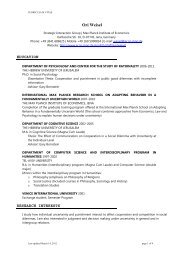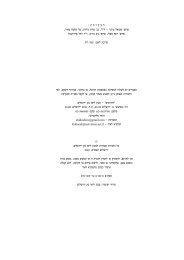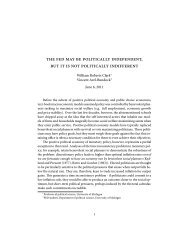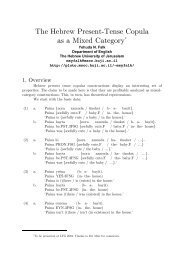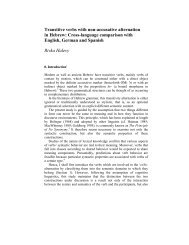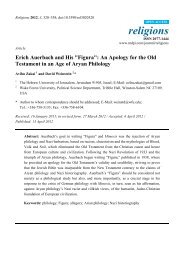View - Pluto Huji Ac Il
View - Pluto Huji Ac Il
View - Pluto Huji Ac Il
Create successful ePaper yourself
Turn your PDF publications into a flip-book with our unique Google optimized e-Paper software.
cial and questionable assumptions discussed in Section 3. Section 4 extends the selection<br />
criterion of Sections 2 and 3, and Section 5 concludes with a comparative discussion of frequentist<br />
and Bayesian analyses under publication bias. It also discusses the ability of the<br />
aforementioned initiative of registering studies in a public database to solve the concerns<br />
that arise by selection of results.<br />
2 A BINOMIAL MODEL<br />
Pharmaceutical companies perform Phase I toxicity studies on drugs and doses on a regular<br />
basis in order to screen out drugs that have significant adverse effects. Because of competition,<br />
they disclose only the minimum information necessary to get their drugs approved.<br />
The mission of public agencies such as the FDA is to ensure that approved drugs are indeed<br />
safe for use.<br />
Consider such a pharmaceutical company and suppose that for each experiment it conducts,<br />
the company statistician computes a confidence interval for θ, the probability of<br />
an adverse reaction to the drug. Each interval is based on the number of toxic cases in<br />
the given experiment, which is a Binomial random variable X ∼ Bin(n, θ), where n is the<br />
number of patients in the experiment, assumed fixed.<br />
Typically, there is a maximal probability of adverse reaction, θ M , corresponding to the<br />
Maximum Tolerated Dose (MTD), which is the maximal value of θ acceptable for a given<br />
disease. A drug would be accepted if all values in a computed confidence interval lie below<br />
θ M . For severe diseases, such as certain types of cancer, this value may be up to θ M = 0.2<br />
or 0.25.<br />
There are several methods for constructing 1−α level confidence intervals for θ, see, e.g.,<br />
Brown, Cai and DasGupta (2001) for a review. Here we consider the conservative method<br />
of Clopper and Pearson (1934) that, for X = x, solves for θ the equations Pθ(X ≥ x) = α/2<br />
and P θ (X ≤ x) = α/2 and defines the confidence interval CP (X) = [θ , θ ]. The function<br />
Pθ(X ≤ x) is decreasing in θ so that multiple solutions do not exist. However, for x = 0,<br />
the first equality has no solution and the interval uses 0 as its left limit. Likewise, for<br />
x = n, the right limit of the interval is 1.<br />
For example, for n = 20 and α = 0.05, this yields for X = 7 the interval CP (7) =<br />
[0.1539, 0.5922]. The interval CP (7) includes high toxicity levels that under normal circumstances<br />
are not acceptable, hence the drug will not be approved. Here we consider a<br />
scenario in which drugs or doses associated with experiments resulting in such a high number<br />
of cases of adverse reactions are deemed useless by the company, and therefore such<br />
experiments are not disclosed to the public. Thus, only successful experiments, say with<br />
X ≤ c adverse reactions for some c, and their associated confidence intervals are published<br />
and no information on unsuccessful experiments, including their number and outcomes, is<br />
revealed. For simplicity, we first discuss the case of c = 1 . We elaborate on the choice of<br />
c in Section 4, where it is also shown that the main issues discussed below are not specific<br />
to a particular choice of this parameter.<br />
Continuing the example of n = 20 and α = 0.05, if c = 1 then only X = 0 or 1<br />
would be considered. The Clopper-Pearson intervals are CP (1) = [0.0013, 0.2487] and<br />
CP (0) = [0, 0.1684], possibly suggesting an acceptable level of toxicity.<br />
Suppose a regulator claims that the selection policy of the company distorts the results,<br />
and, however large θ is, the outcomes X = 0 or 1 will occur eventually. And so, the<br />
regulator says, in order to achieve good results, all the company has to do is to perform<br />
2



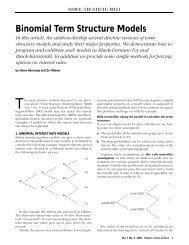
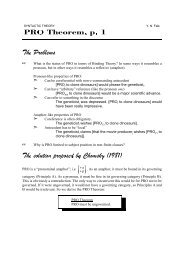
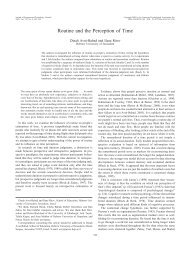
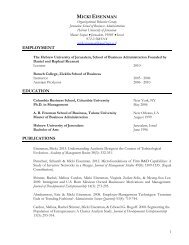
![CV [PDF] - Pluto Huji Ac Il](https://img.yumpu.com/18174585/1/190x245/cv-pdf-pluto-huji-ac-il.jpg?quality=85)
